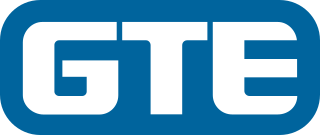Related Research Articles
Telecommunications in France are highly developed. France is served by an extensive system of automatic telephone exchanges connected by modern networks of fiber-optic cable, coaxial cable, microwave radio relay, and a domestic satellite system; cellular telephone service is widely available, expanding rapidly, and includes roaming service to foreign countries.

GTE Corporation, formerly General Telephone & Electronics Corporation (1955–1982), was the largest independent telephone company in the United States during the days of the Bell System. The company operated from 1926, with roots tracing further back than that, until 2000, when it was acquired by Bell Atlantic; the combined company took the name Verizon.

ITT Inc., formerly ITT Corporation, is an American worldwide manufacturing company based in Stamford, Connecticut. The company produces specialty components for the aerospace, transportation, energy and industrial markets. ITT's three businesses include Industrial Process, Motion Technologies, and Connect and Control Technologies.

Xenix is a discontinued version of the Unix operating system for various microcomputer platforms, licensed by Microsoft from AT&T Corporation in the late 1970s. The Santa Cruz Operation (SCO) later acquired exclusive rights to the software, and eventually replaced it with SCO UNIX.

NEC Corporation is a Japanese multinational information technology and electronics corporation, headquartered at the NEC Supertower in Minato, Tokyo, Japan. It provides IT and network solutions, including cloud computing, artificial intelligence (AI), Internet of Things (IoT) platform, and telecommunications equipment and software to business enterprises, communications services providers and to government agencies, and has also been the biggest PC vendor in Japan since the 1980s when it launched the PC-8000 series.

The Santa Cruz Operation, Inc. was an American software company, based in Santa Cruz, California, that was best known for selling three Unix operating system variants for Intel x86 processors: Xenix, SCO UNIX, and UnixWare.

Logica plc was a multinational IT and management consultancy company headquartered in London and later Reading, United Kingdom.

Stratus Technologies, Inc. is a major producer of fault tolerant computer servers and software. The company was founded in 1980 as Stratus Computer, Inc. in Natick, Massachusetts, and adopted its present name in 1999. The current CEO and president is Dave Laurello. Prior to 2022, Stratus Technologies, Inc. was a privately held company, owned solely by Siris Capital Group. The parent company, Stratus Technologies Bermuda Holdings, Ltd., was incorporated in Bermuda. In 2022, the company was acquired by SGH and currently operates within SGH's Intelligent Platform Solutions (IPS) business.

Cable & Wireless plc was a British telecommunications company. In the mid-1980s, it became the first company in the UK to offer an alternative telephone service to British Telecom. The company later offered cable TV to its customers, but it sold its cable assets to NTL in 2000. It remained a significant player in the UK telecoms market and in certain overseas markets, especially in the former British colonies of the Caribbean, where it was formerly the monopoly incumbent. It was also the main supplier of communication in the British South Atlantic, including Saint Helena and the Falkland Islands. It was listed on the London Stock Exchange and was a constituent of the FTSE 100 Index.

GCI Communication Corp (GCI) is a telecommunications corporation operating in Alaska. Through its own facilities and agreements with other providers, GCI provides cable television service, Internet access, wireline (networking), and cellular telephone service. It is a subsidiary of Colorado-based company Liberty Broadband, a company affiliated with Liberty Media that also owns a 26% interest in Charter Communications, having been originally acquired by Liberty in 2015.
Rochester Telephone Corporation was a company that provided local telephone service to Rochester, New York. The company was founded in 1920 as a merger of Rochester Telephonic Exchange and Rochester Telephone Company. In 1995 the company became Frontier Corporation, trading on the NYSE under the FRO symbol. Ownership passed to Global Crossing in 1999, and then, in 2001, to Citizens Utilities Corporation, which later changed its name to Frontier Communications.

PLDT, Inc., formerly known as the Philippine Long Distance Telephone Company, is a Philippine telecommunications, internet and digital service company.
AT&T Information Systems (ATTIS), originally known as American Bell, was the fully separate subsidiary of American Telephone & Telegraph Company (AT&T) which focused on computer technology ventures and telephone sales, and other unregulated business. It was one of the three core units of AT&T formed after the breakup of the Bell System. As a twenty-five percent owner, AT&T Information Systems utilized production of Olivetti to manufacture their AT&T PC 6300 series of computers. Along with the 3B series computers and the AT&T UNIX PC the PC 6300 series of computers represented a multi-faceted strategy of competing with IBM, who was the leading computer manufacturer of the time.
Computer Consoles Inc. or CCI was a telephony and computer company located in Rochester, New York, United States, which did business first as a private, and then ultimately a public company from 1968 to 1990. CCI provided worldwide telephone companies with directory assistance equipment and other systems to automate various operator and telephony services, and later sold a line of 68k-based Unix computers and the Power 6/32 Unix supermini.

Alcatel–Lucent S.A. was a multinational telecommunications equipment company, headquartered in Boulogne-Billancourt, France. It was formed in 2006 by the merger of France-based Alcatel and U.S.-based Lucent, the latter being a successor of AT&T's Western Electric and a holding company of Bell Labs.
Y!mobile is a Japanese mobile phone operator. Y!mobile is a brand used by SoftBank Corp., a subsidiary of Japanese telecommunications company SoftBank Group Corporation, that provides mobile telecommunications and ADSL services. The current CEO of the company is Ken Miyauchi. It was formed in 2014 through the merger of Willcom and eAccess, and uses the Y! moniker brand from Yahoo! Japan, which is partly-owned by SoftBank.
CT Connect is a software product that allows computer applications to monitor and control telephone calls. This monitoring and control is called computer-telephone integration, or CTI. CT Connect implements CTI by providing server software that supports the CTI link protocols used by a range of telephone systems, and client software that provides an application programming interface (API) for telephony functions.
Visionware Ltd was a British software company that developed and marketed products that helped integration of Microsoft Windows clients to Unix-based server applications. It was based in Leeds in West Yorkshire. The three products it was most known for were PC-Connect, XVision, and SQL-Retriever.

Human Computing Resources Corporation, later HCR Corporation, was a Canadian software company that worked on the Unix operating system and system software and business applications for it. Founded in 1976, it was based in Toronto.
Systime Computers Ltd was a British computer manufacturer and systems integrator of the 1970s and 1980s. During the late 1970s and early 1980s, Systime become the second largest British manufacturer of computers, specializing in the minicomputer market.
References
- ↑ Per general view of these search snippets.
- 1 2 Official Gazette of the United States Patent Office, Volume 767. United States Department of Commerce. 1961. p. TM 61.
- ↑ "Four Firms Join WEMA". San Mateo Times. March 27, 1961. p. 9 – via Newspapers.com.
- 1 2 3 Vernon, Tom (March 14, 2018). "Jim Wood Focuses on the Basics". Radio World. pp. 3–5. ProQuest 2030180480.
- ↑ As indicated by 'help wanted' advertisements during this period, see for instance "Electronics Technicians". Santa Maria Times. April 22, 1966. p. 39 – via Newspapers.com.
- 1 2 "Continental Okays Vidar Purchase Plan". The Indianapolis Star. New York Times News Service. May 3, 1970. p. 4 (Section 3) – via Newspapers.com.
- ↑ "Business Briefs". Los Angeles Evening Citizen News. May 5, 1970. p. 15 – via Newspapers.com.
- 1 2 3 Koshetz, Herbert (May 15, 1975). "Assets of Vidar Sold to TRW, Inc". The New York Times. p. 82.
- ↑ "California Microwave buys TRW Vidar area". San Francisco Examiner. June 25, 1982. p. C1 – via Newspapers.com.
- ↑ "uncertain". Telephone Engineer & Management. 1977. p. 61 (issue uncertain).
- 1 2 "The 1978 AFCEA Sustaining and Group Member Capabilities Directory: TRW Vidar". SIGNAL Magazine. January 1978. pp. 78, 132.
- 1 2 Dittberner Associates, Inc. (1977). DTIC ADA055519: Telephone Switching Technology Survey. Washington, D.C.: Defense Technical Information Center. pp. 106–109.
- 1 2 3 4 5 6 Oates, Sarah (October 25, 1989). "Company thriving after switch in owners". The Orlando Sentinel. pp. F-1, F-2.
- ↑ "Editor's Notes". Embedded Muse. The Ganssle Group. April 7, 2008.
- ↑ "TRW-Vidar Switching Systems". Telephone World. Retrieved May 23, 2021.
- ↑ Bellamy, John (1982). Digital Telephony. New York: John Wiley & Sons. p. 48. ISBN 9780471080893.
- ↑ "Our History". Palmerton Telephone. Retrieved May 26, 2021.
- 1 2 3 Patterson, Rick (March 7, 1982). "ITT, TI point to recovery". Johnson City Press-Chronicle. p. 2A – via Newspapers.com.
- 1 2 3 "American Digital Switching - formed to serve independent telco switch market". Telephone News. October 2, 1989. p. 8 – via Gale General OneFile.
- 1 2 Falk, Bennett; Eisenhart, Mary (February 1987). "The Santa Cruz Operation: Taking Care Of Business With XENIX". MicroTimes. pp. 46–54. At p. 48.
- ↑ Bezroukov, Nikolai (July 28, 2019). "XENIX – Microsoft Short-lived Love Affair with Unix". Softpanorama. Retrieved May 27, 2021.
- 1 2 3 "Firms involved in almost every facet of cellular technology". Florida Today. May 28, 2000. p. 8A B – via Newspapers.com.
- 1 2 "Symetrics Industries buys American Digital". Orlando Sentinel. May 1, 1996. ProQuest 278801587.
- ↑ "Legals: Notice of Sheriff's Sale". Florida Today. September 27, 2001. p. 11F – via Newspapers.com.